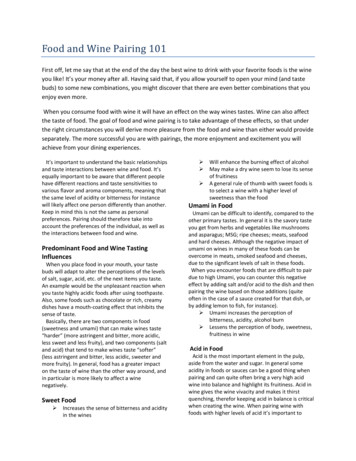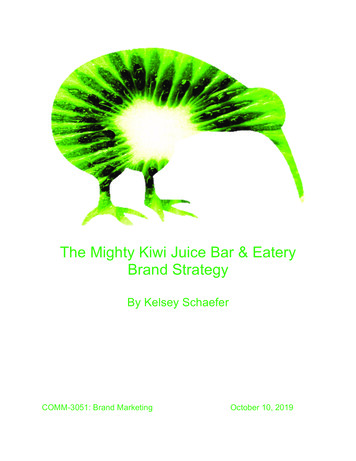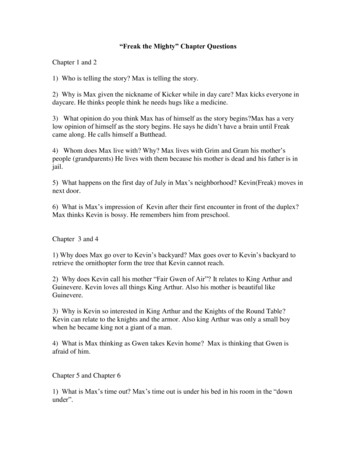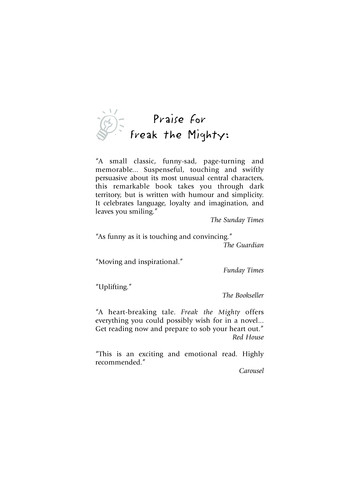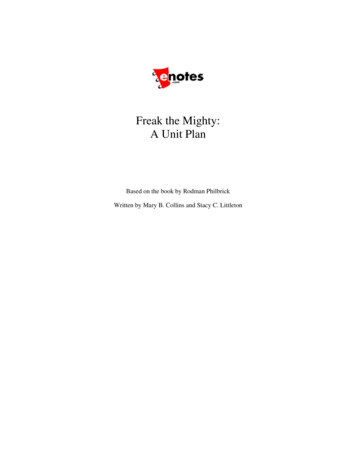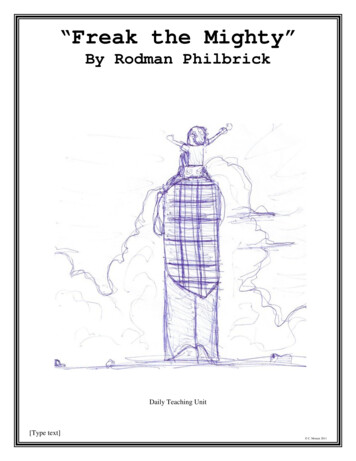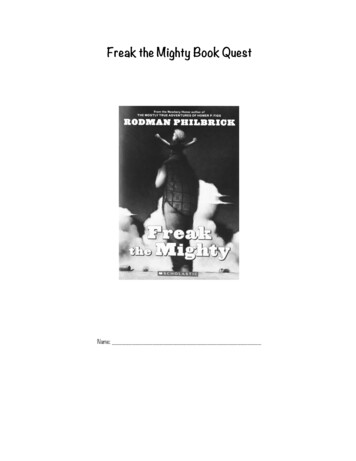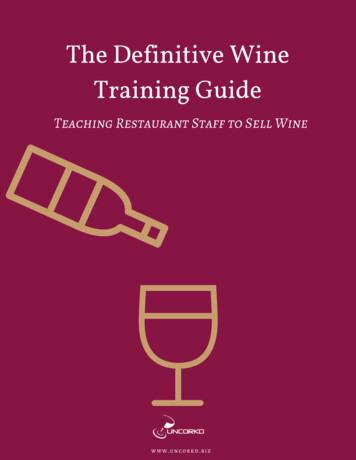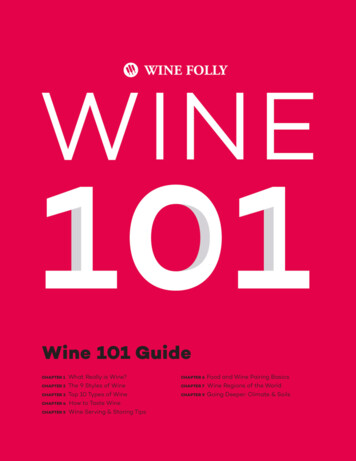
Transcription
Wine 101 GuideCHAPTER 1CHAPTER 2CHAPTER 3CHAPTER 4CHAPTER 5What Really is Wine?The 9 Styles of WineTop 10 Types of WineHow to Taste WineWine Serving & Storing TipsCHAPTER 6CHAPTER 7CHAPTER 9Food and Wine Pairing BasicsWine Regions of the WorldGoing Deeper: Climate & Soils
What is Wine?GROCERY STOREGRAPESWINE GRAPESWine is an alcoholic beverage made withfermented grapes.Of course, you can ferment any fruit to makewine. But legally speaking, if it’s labeled “wine”then it must be made with grapes. Other fruitwines must append the fruit type to the label(e.g. “cranberry wine.”)The grapes used for winemaking are not likethe ones you’ll find in the grocery store. Winegrapes are smaller, sweeter, have thicker skins,and contains seeds. These attributes givewine its unique acquired taste.What’s surprising is most wine is made fromgrapes of a single species called Vitis vinifera.This species originated in the CaucasusMountains of Eastern Europe. We’ve madewine with this species for about 10,000 years.Once a year, grapes are harvested to makewine. This is where we get the term “vintage.”Each vintage is characterized by uniquegrowing conditions (rainfall, wind, frost, hail,fires, etc) that ultimately affect how the winetastes. This is why you’ll find some vintagespreferrable to others.It’s useful to note that a single vintagecan affect red and white wines somewhatdifferently.Today, there are about 1,400 grape cultivarsused in commercial wine production. That said,only about 100 of these varieties make up75% of the world’s vineyards. This means somewines you’ll discover are made with very rarewine grapes.WINE 101 GUIDE WINE FOLLY
ull-BodiedSTYLES OFWINERedOther With so many options out there, how do you hone in onyour favorites? Well, as diverse as wine is, most winescan be categorized into 9 styles. Once you try each ofthe 9 styles, you’ll have a pretty good idea of what youlike and don’t like.Consider this a homework assignment.Taste at least one wine from each of the 9 styles overthe next month (or so) and take detailed, objectivenotes. (Use the tasting method included in this guide!)WINE 101 GUIDE WINE FOLLY
SPARKLINGWINESparkling wines are characterized by carbonationcaused from a second fermentation. This gives bubblywines distinct yeasty andbready aromas.Sparkling wines come in allstyles (white, rosé, and red)and sweetness levels. Thelabel terms “Brut,” “ExtraBrut,” and “Brut Nature” arethe most dry (e.g. not sweet.)LIGHT-BODIED WHITEWINELight-bodied, easy-drinkingdry white wines may notcommand high prices, butare some of the most-soldwines in the world (even ifred wines get more attention.)Light whites have increasedacidity and thus, pair witha wide array of cuisines.Aromas range from sweeter stone fruits to savory,herby, and peppery flavors.WHAT TO TRYCAVACHAMPAGNECRÉMANTCAP CLASSIQUEPROSECCOLAMBRUSCOSEKTAMERICAN SPARKLERSWHAT TO TRYPINOT GRIGIO (AKA PINOT GRIS)SAUVIGNON BLANCCHENIN BLANCMUSCADET*ALBARIÑOASSYRTIKOGARGANEGA (SOAVE)GRÜNER VELTLINERCHASSELASVERMENTINOVERDICCHIOVINHO VERDEPICPOUL*French regional wine made with Melongrapes.FULL-BODIED WHITEWINEFull-bodied white wines aregreat wines for red winelovers because of their richsmooth taste and subtlecreamy notes.What makes white wines sorich? Aging white wines inoak barrels causes severalinteractions to occur thatincrease body. So, be sureto look up the aging program to ensure the winehas had some barrel aging(usually from 6–12 months.)WHAT TO TRYCHARDONNAYVIOGNIERMARSANNEROUSSANNEGRENACHE BLANCSÉMILLONAGED RIOJA BLANCOWINE 101 GUIDE WINE FOLLY
AROMATIC WHITE WINEAromatic grapes includesome of oldest wine varieties in the world. In fact,Cleopatra was noted tolove of Muscat of Alexandria–a rich, aromatic sweetwine from Greece.Expect explosive, perfumedaromas that spring out ofthe glass. Aromatic whitesare available in dry or sweetstyles, but often taste atouch sweet because oftheir sweet aromas.ROSÉ WINERosé is made by “dying” thewine for a short time withred grape skins. Rosé firstbecame popular in the late1700’s when French Bordeaux wines imported toEngland had a pale colorand were called Claret.Nearly any red grape canbe made into rosé. Also, it’spossible to blend in whitewines to add acidity andcomplexity.WHAT TO GEWÜRZTRAMINERMOSCHOFILERO*Various regional names for wines madewith Muscat Blanc grapes.WHAT TO TRYPROVENCE ROSÉSANGIOVESE ROSÉGARNACHA ROSÉPINOT NOIR ROSÉSYRAH ROSÉCABERNET FRANC ROSÉBEAUJOLAIS ROSÉWHITE ZINFANDEL (SWEET)The world’s largest rosé region is Provence, France.LIGHT-BODIED REDWINELight-bodied red wines aretypified by their translucentcolor, light tannin, increasedacidity, and delicate, floralherbal aromas.Light-bodied red wines arevery versatile food wines –they make a perfect matchwith poultry.This style is growing inpopularity given that itpairs with a wide variety ofcuisines.WHAT TO TRYPINOT NOIRGAMAYBEAUJOLAIS*FRAPPATOCINSAULTNERELLO MASCALESESCHIAVAZWEIGELTLAMBRUSCO***A French regional wine of 100% Gamay**Sparkling styleWINE 101 GUIDE WINE FOLLY
MEDIUM-BODIED REDWINENot too light nor too heavy,this is the “baby bear” redwine style. There are a widearray of choices (and thus,flavors) in this red winecategory. Tannin is moderate, and expect most tohave slightly higher acidity.The aforementioned traitsmake for a wine that canpair with most foods (butavoid super delicate dishes.) Additionally, many ofthese wines have the structure to age well.FULL-BODIED RED WINEFull-bodied red wines arethe deepest, darkest, andhighest in tannin of the redwines. Despite what youmight have heard about it,tannin is what gives wineantioxidant properties. Additionally, it ensures manyof these wines will age fordecades.Bold red wine pairs wellwith fatty, umami-drivenfoods because of their hightannin. Truthfully though,you might want to ditchthe food altogether – theydrink well solo.DESSERT / OTHER WINEIn the 1800’s, sweet wineswere more popular than drywines. In fact, several ofthe most exalted wines inthe world, from Sauternesin Bordeaux to Tokaji Aszúfrom Hungary, will age justas long as bold red wines(or longer!)The dessert wine style isactually a catchall for someof the more rare wines ofthe world. Each is madewith a unique method andrange from dry to sweet.WHAT TO NET FRANCDOLCETTOCARMÉNÈREBLAUFRÄNKISCHVALPOLICELLA ELWHAT TO TRYCABERNET SAUVIGNONSYRAH (AKA SHIRAZ)BORDEAUX BLENDMALBECSYRAHMONASTRELLNERO D’AVOLAPETITE SIRAHPINOTAGESAGRANTINOTANNATTOURIGA NACIONALWHAT TO TRYSHERRYPORTSAUTERNAISICE WINEMADIERAMARSALAMOSCATEL DE SETÚBALVIN SANTOMUSCAT OF ALEXANDRIAWINE 101 GUIDE WINE FOLLY
The Major Types of WineBY THE NUMBERSLet’s zoom out a little to get perspective on whatgrapes are at the top. The grapes included here arethe most planted varieties. They represent a largeportion of what’s available in the market.Chances are, you might already be familiar with what’slisted here. That said, there are a couple of unfamiliarwine grapes included which are used primarily forbrandy (Cognac, etc) or balsamic vinegar production!CABERNET SAUVIGNONCABERNET SAUVIGNONRED BACEOICESPCabernet Sauvignon (“cab-err-nay saw-vin-yon”) isthe most planted wine variety in the world. Wines arerich, red, and robust. This grape originated in Francearound the region of Bordeaux.FLAVORSBLACK CHERRY, BLACK CURRANT, CEDAR, BAKINGSPICES, GRAPHITEThe rich flavor and high tannin content in CabernetSauvignon make it a perfect partner to seasonedgrilled meats, peppery sauces, and dishes with highflavor.SUBAPERPEPEARTHMERLOTMERLOTRED BACEOICESP(“murr-low”) Despite what some say, Merlot is actuallyvery closely related to Cabernet Sauvignon. Wines areusually considered slightly more fruity than CabernetSauvignon but can age just as long.FLAVORSCHERRY, PLUM, CHOCOLATE, BAY LEAF, VANILLAMerlot tastes great alongside roasted dishes likepork shoulder, broiled mushrooms, or braised shortribs. Try complementing Merlot’s fruit flavors withchimichurri sauce.SUBAPERPEPWINE 101 GUIDE WINE FOLLYEARTH
THE MAJOR TYPES OF LOFLAVORSAPPLE, PINEAPPLE, GRAPEFRUIT, BANANA, ROSEMadrid-inspired tapas and warm weather.HONEYITYALERINBITTERNESSPICAL FRUITTROSpain’s most widely planted grape is primarily used forbrandy. That said, a few producers have revitalized theold, drought-resistant bush vines for winemaking. Still,it’s quite hard to find outside of Spain.MDYBOCREAMINESSTEMPRANILLOTEMPRANILLORED s top variety, made famous by the region of Rioja, where wines are classified by how long they age inoak. A well-made Tempranillo will age over 20 years.FLAVORSCHERRY, DRIED FIG, CEDAR, TOBACCO, DILLBolder, aged Tempranillo wines pair nicely withsteak, gourmet burgers, and rack of lamb. Fresherstyles match well with Mexican street food and eventomato dishes.CHARDONNAYTSUEREUITFRPICAL Chardonnay originated from the Burgundy region ofFrance and produces a wide range of styles from bold,buttery, oak-aged still wines to lean, Blanc de Blancssparkling wines.FLAVORSYELLOW APPLE, STARFRUIT, PINEAPPLE, VANILLA,BUTTER, LEMONIf you keep spice and flavor intensity slightly lowerand choose dishes with creamy, buttery flavors thenyou will be delighted. This is a wine worthy of lobster.MDYBOWINE 101 GUIDE WINE FOLLYCREAMINESS
THE MAJOR TYPES OF WINESYRAHSYRAHRED ALSUBAEARTHPERPEPRED FRUITHERBACEODYBOAlso known as Shiraz in Australia, this grape producesboisterous, rich, and peppery reds. Syrah originatedclose to the Northern Rhône of France.FLAVORSTART BLUEBERRY, BLACK PLUM, CHOCOLATE,TOBACCO, GREEN PEPPERCORNDarker meats and exotic spices bring out the fruitnotes of Syrah. Try it with lamb shawarma, gyros,Asian five-spice pork, and even Indian tandoori ALFLOAlso known as Garnacha in Spain, this grape producesjuicy, spice-driven, medium-bodied red wines with redberry flavors and elevated alcohol. Evidence suggestsGrenache is originally of Spanish origin.FLAVORSSTEWED STRAWBERRY, GRILLED PLUM, LEATHER,DRIED HERBS, RUBY RED GRAPEFRUITThe high intensity flavors of Grenache match wellwith roasted meats and vegetables spiced with Asianfive-spice and cumin.SAUVIGNON BLANCTSUEREUITFRPICAL FRUITTROHONEYITYALERINBITTERNESSHERBACEOSAUVIGNON BLANCA popular and unmistakable white that’s loved for its“green” herbal flavors and sky high acidity. This Frenchorigin grape turns out to be one of the parents ofCabernet Sauvignon.FLAVORSGOOSEBERRY, HONEYDEW MELON, GRAPEFRUIT,WHITE PEACH, PASSION FRUITA wonderful choice with herb-driven sauces overchicken, tofu, or fish dishes. Try matching SauvignonBlanc with Thai and Vietnamese cuisine.MDYBOWINE 101 GUIDE WINE FOLLYCREAMINESS
THE MAJOR TYPES OF WINETREBBIANO TOSCANOTREBBIANO TOSCANO(AKA UGNI ALERINBITTERNESSPICAL FRUITTROAlso known as Ugni Blanc in France, this grape isprimarily used in the production of Cognac, Armignac,and balsamic vinegar in Italy.FLAVORSLEMON, HONEYDEW MELON, GOOSEBERRY, CRUSHEDROCKS, LIME PEELAs a dry white wine, Trebbiano pairs well with hardItalian cheeses, seafood pastas, white pizza, roastchicken, and pesto.MDYBOCREAMINESSPINOT NOIRPINOT NOIRRED BACEOICESPThe world’s most popular light-bodied red is loved forits red fruit and spice flavors that are accentuated bya long, smooth, soft-tannin finish.FLAVORSCHERRY, RASPBERRY, MUSHROOM, ALLSPICE,HIBISCUSA very versatile food pairing wine given it’s higheracidity and lower tannin. Pinot Noir pairs particularlywell with duck, chicken, pork, and mushrooms.SUBAPERPEPNeed information on a specific wine orgrape variety? Search our free infobase!SEARCH GRAPE DATABASEWINE 101 GUIDE WINE FOLLYEARTH
How to Taste WineThe singlemost importantstep towardsimproving yourpalate.Active tasting is alearned skill. Thismethod will give youthe framework toimprove your ability toassess wine quality.Practice makes perfect! Be sure to usethis method each timeyou taste a new wine.LOOKSMELLTASTETHINKA visual inspection of the wine underneutral lightingIdentify aromas through orthonasalolfaction (e.g. breathing through yournose)Assess both the taste structure (sour,bitter, sweet, etc) and flavors derivedfrom retronasal olfaction (e.g. breathingwith the back of your nose)Take a pause to solidify the taste profileof the wine into your long term memoryWINE 101 GUIDE WINE FOLLY
HOW TO TASTE STEP 1: LOOKVIEW “COLOR OF WINE” POSTER Hold a glass of wine over a white backgroundunder neutral lighting and observe.1. Identify the hue2. Inspect intensity (how opaque is it?)3. Check viscosity (watery or viscous?)HUEHere are some common hints you can look forin the color and rim variation –Often Nebbiolo and Grenache-based wineswill have a translucent garnet or orangecolor on their rim, even in their youth.HELPFUL TIPSAs white wines age they oxidize and changecolor, becoming deeper yellow. A fully oxidizedwhite wine is brown.As red wines age, they lose color, becomingmore transparent and faded with a moreorange or tawny-colored rim.If you see sediment in the wine, it’s not bad foryou! It’s just a sign of an unfiltered wine. Mostconsider this a highly desirable trait.Pinot Noir will often have a true-red or trueruby color, especially from cooler climates.Malbec will often have a magenta-pink rim.INTENSITYHow intense and opaque is the color in theglass? Can you see sediment in the wine?These are general clues that can help youidentify the variety and concentration of thewine.VISCOSITYThe tears that form on the side of the glass(“wine legs”) can tell us if the wine has highor low alcohol and/or high or low sugar. Thethicker and more viscous the legs, the morealcohol or residual sugar in the wine.Grab a glass and taste with Madeline P.WATCH VIDEO WINE 101 GUIDE WINE FOLLY
HOW TO TASTE STEP 2: SMELLAll aromas found in wine are derived fromchemical interactions between the grape juice,the yeast fermentation, and the aging method.GRAPE-DERIVEDAROMASPRIMARYAROMASAromas in wine can reveal almost everythingabout a wine including grape variety(ies) used,oak or aging regime, region, and even vintage.A well-trained nose can pick out each ofthese details. In fact, it’s one of the primarychallenges to becoming a Master Sommelier.Your goal with this step is to isolate a wine’sindividual aromas so that you can use themas clues to define what the wine is, how it wasmade, and where it came from.For example, knowing that the smell ofvanilla indicates a higher presence of vanillinsuggests the wine was likely aged in oak.HELPFUL TIPSFind Your Position Hold your glass right underyour nose and slowly move it away (whilesniffing) until you can pick out individualaromasSwirling Wine in your glass concentrates thearomas and can help you pick out flavors moreeasilyOverloaded? If your nose is overloaded, smellyour forearm. It helps reset your nose.Tasting is generally more about the texturethan flavor, so pay attention to that first.TERTIARYAROMASAGING & OAKAROMASSECONDARYAROMASFERMENTATIONAROMASTo simplify this incredibly complexinterrelationship (unless you’re studyingfermentation science), we can sort aromas intothree categories:Primary Aromas are derived from theinteraction between the grape and yeastand can include fruit, flower, and herb-likeflavors.Secondary Aromas are derived primarilyfrom yeast and other microbes and mayinclude aromas like yeast, cheese, cream,sourdough, or beer-like smells.Tertiary Aromas are derived from agingand oxidation (including aging in oakbarrels) and may include vanilla, maple,browned butter, and nut-like aromas.WINE 101 GUIDE WINE FOLLY
HOW TO TASTE STEP 3: TASTESweetness: The first thing to look for. Is thewine sweet or is it dry? Most people tastesweetness towards the front of the tonguewhere they have the highest proportion oftastebuds.Acidity: How sour is the wine? Does it makeyour mouth water? All wines lie on the acidicside of the pH spectrum. A wine with a lowpH (e.g. high acidity) will cause your mouth tosalivate and tingle more than a wine with ahigh pH.When we taste we’re essentiallytouching wine and sensing how itfeels.Thus, a large part of the tasting portion isdedicated to texture. This step ultimatelyreveals a wine’s physical traits includingsweetness, acid level, tannin, and alcohol.The moment you taste wine theflavor evolves on your palate untilit’s no longer present.Some wines will continue to deliver tastesensations on your palate long after you’veswallowed.Tannin: How astringent or mouth-drying is thewine? This is a trait found is most red winesand less so in white wines. You can feel tanninson the middle and sides of your tongue as amouth-drying, bitter sensation. As negative asthese taste traits may sound, tannins in wineare one of the few wine traits that are actuallygood for you!Alcohol: When you swallow, pay attention tothe warming sensation in your throat. Thisis how most of us sense the alcohol level inwine. High alcohol wines often have a burningsensation and because of this are oftendescribed as tasting “hot.”Body: How “big” is the wine on yourpalate? Does it fill your mouth with flavor andrichness or is it lean and lithe? While body isnot a scientific term, it can really help describewhat we like/dislike in wine.Finish: What flavor or taste does the winefinish with? Is it bitter? sweet? smoky? oily?salty? It’s interesting to note that the finishis one of the deciding factors behind whatconsumers like.Length: How long does it take until you can’ttaste the wine on your palate? Even a verylight-weight wine can have a long length.Layers: Does the wine’s flavors and textureschange over the course of a single taste? If so,the wine is “layered.”VIEW WINE FLAVOR CHART WINE 101 GUIDE WINE FOLLY
HOW TO TASTE STEP 4: THINKREADING WINE RATINGSOften times you’ll find a point-scoreassociated with a bottle of wine. The mostcommon rating scale is the 100-point system(developed by Robert Parker). Additionally,there is a 5-star system (used on Vivino) and a20-point scale (more common in the UK).A high rating doesn’t gaurantee that you’lllove a wine. Instead, a good rating is a generalindication of quality within a style or a goodquality-to-price ratio.Developing a highly tuned winepalate takes time.Thus, make sure you like the style of wine firstbefore using ratings to hone in on a purchasechoice.You can accelerate the process by thinkingcarefully after tasting a new wine. The goal isto pick out the key characteristics of a winein the way it looks, smells, and tastes. Whatmakes this wine different than others?LEGENDARYEPICGOODBELOWAVERAGEYour wine repertoire is as big as you choose tomake it.By continually trying new wines, new vintages,and new wine regions you’ll create a diversewine repertoire. What’s cool is that it reallydoesn’t matter if you spend a lot or a little ona bottle of wine. What’s more important is thatyou’re actively tasting new 3.54.5BALANCEDoes the wine’s taste characteristics ofacidity, alcohol, and tannin work in balancewith one another? Or does the wine have atrait that tends to dominate the others?While balance is not necessarily an indicatorof quality, you’ll find many highly rated winesare noted for being balanced.COMPLEXITYDoes the wine have an endless number offlavors and textures to identify? Or does thewine only have one or two major flavors?Keep track ofyour tastingnotes with thiscustom WineTasting Journal.VIEWGenerally speaking, wines with high complexityare considered higher quality.WINE 101 GUIDE WINE FOLLY
Tips on Serving & Storing WineSPARKLING WINESServe “Ice Cold” (38–45 ºF / 3–7 ºC)Store open 1–3 days* (store in fridge)LIGHT WHITE & ROSÉ WINESServe “Cold” (45–55 ºF / 7–13 ºC)Store open 5–7 days* (store in fridge)FULL-BODIED WHITE WINESServe “Cold” (45–55 ºF / 7–13 ºC)Store open 3–5 days* (store in fridge)RED WINESServe “Cellar Temp” (55–68 ºF / 13–20 ºC)Store open 3–5 days* (in cool, dark place)Decant for at least 30 minutesFORTIFIED & BOX WINESServe “Cellar Temp” (55–68 ºF / 13–20 ºC)Store open 28 days* (in cool, dark place)Box Wines*Freshness varies, some wines last open longer.WINE 101 GUIDE WINE FOLLY
CHOOSING GLASSWARESPARKLING WINESFULL-BODIEDRED WINESLIGHT WHITEWINESROSÉ WINESDRY SHERRYAROMATICWHITE WINESFULL-BODIEDWHITE WINESMEDIUM-BODIEDRED WINESDESSERTWINESLIGHT-BODIEDRED WINESIn a perfect world, you can have one glass for every style of wine. In a pragmatic world, owning 1–2 glass types is sufficient.You can drink wine from whatever vessel youwant, be it a wine glass, coffee mug, mason jar,or dixie cup! That said, certain glasses do workbetter than others on certain wines.Here are the major things to consider whenchoosing glassware:Most importantly, in order to sense thedifferent aromas in wine, you’ll need addedspace in the glass above the liquid. You’ll findthat most quality glasses have increasedvolume capacity ranging from about 11 to 22ounces. (325 ml to 620 ml)For most white wines, a slightly smaller bowledglass with a smaller diameter opening ispreferred. Here’s how these two traits affectaromas:Preserves floral aromasMaintains a cooler temperatureBetter expresses acidity in wineDelivers more concentrated aromasConversely, full-bodied white wines like oakaged Chardonnay, Viognier, White Rioja, andorange wines are better with a larger bowl.do with mitigating the bitterness of tanninor spicy flavors to deliver a smoother tastingwine. We’ve observed red wine glasses tend tohave a larger bowl shape and larger diameteropening. Here are a few pointers:A globe-shaped glass is ideal for morearomatic, light-bodied red wines such asPinot Noir or Gamay.A large glass with a wider diameter openingis better for big, bold, red wines with hightannin such as Cabernet Sauvignon.A large glass with a smaller diameteropening is generally better for spicy andpeppery red wines such as Syrah, Zinfandel,or Sangiovese.Related Study: In 2015, a study came out bya Japanese group that developed a specialcamera to record evaporating ethanol. Thestudy recorded the density and position ofethanol vapors in different glass shapes.The vapor patterns revealed that wine glassesare the most effective at delivering aromaticcompounds to our noses.The choice of a red wine glass has a lot toWINE 101 GUIDE WINE FOLLY
Food & Wine Pairing BasicsVIEW ALLWINEPOSTERS Even though the science of flavor pairing iscomplex, anyone can learn the fundamentalsand make great wine pairings.The goal with a great pairing is to createharmony between food and wine. The firstthing to do to achieve this is to start thinkingof wine more like an ingredient.CONGRUENT PAIRINGA congruent pairing amplifies shared flavorcompounds found in both the wine andthe food. For example, Syrah and blackpepper have a shared compound calledrotundone. Thus, a pairing of Syrah withpeppered steak would be a good example of acongruent pairing.Buttered Popcorn and oaked Chardonnay(both are “buttery”)Barbecue Pork and Zinfandel (both haverich, smokey, “spiced” flavors)Bresaola and Chianti Classico (both havemeaty, earthy notes)Beef MushroomCONGRUENTPAIRINGMany shared compoundsLimeCoconutCOMPLEMENTARYPAIRINGFew shared compoundsCONTRASTING PAIRINGA contrasting pairing creates balance withextreme opposites. In most cases, the wineacts as a palate cleanser to the food. Forexample, a rich, creamy, gooey, mac andcheese can be contrasted by a high aciditysparkling white wine.Blue Cheese and Ruby Port (pungent andcreamy vs. sweet and bitter)Pork Chop and Riesling (umami and rich vs.sweet and acidic)Maple Bacon and Champagne (sweet andumami vs. sour and carbonated)WINE 101 GUIDE WINE FOLLY
Wine Regions of the WorldWine is made in 90 countries around the world.The wine belt. This map is far from accurate but does show general locations of where wine grapes grow.ITALYCHILESANGIOVESE, MONTEPULCIANO, TREBBIANO TOSCANO,BARBERA, PROSECCO, PINOT GRIGIO, NERO D’AVOLA,VERMENTINO, NEBBIOLOCHILE’S UNIQUE VARIETY IS DEFINITELY CARMÉNÈRE.CABERNET GROWS WELL HERE TOOFRANCEMERLOT, GRENACHE (AKA GARNACHA) CABERNETSAUVIGNON, SYRAH, CARIGNAN, CHARDONNAY, CABERNETFRANC, PINOT NOIR, GAMAY, AND SAUVIGNON BLANCSPAINTEMPRANILLO, AIRÉN, MONASTRELL (AKA MOURVEDRE),GARNACHA, VERDEJO, ALBARIÑO, CAVAUNITED STATESCHARDONNAY, CABERNET SAUVIGNON, MERLOT, PINOT NOIR,SYRAH, ZINFANDELGERMANYGERMANY IS MOST KNOWN FOR RIESLING AND SPARKLINGWINESPORTUGALPORTUGAL HAS MANY AMAZING, LESSER KNOWN GRAPESHUNGARYHUNGARY IS A VERY OLD, CLASSIC WINE REGION OF THEWORLD KNOWN FOR UNIQUE VARIETIESBRAZILBRAZIL IS AN UP-AND-COMING WINE REGION OF THE WORLDARGENTINAMALBEC, CABERNET SAUVIGNON, TORRONTÉS, SYRAH,CHARDONNAYAUSTRALIASHIRAZ (AKA SYRAH), CHARDONNAY, CABERNET SAUVIGNON,MERLOT, SAUVIGNON BLANC, MERLOT, SÉMILLON, PINOT NOIR,RIESLINGGREECEGREECE IS A VERY ANCIENT WINE REGION THAT SPECIALIZESIN RARE INDIGENOUS VARIETIESNEW ZEALANDKNOWN MOSTLY FOR SAUVIGNON BLANC AND A HIGHPREVALENCE OF SUSTAINABLE AND ORGANIC WINESWINE 101 GUIDE WINE FOLLY
Going Deeper: Climate & SoilsThe soil porticle size provides a clue towards the quality of a wine produced from a vineyard.CLIMATE TYPES AND WINESOILS AND WINEBeyond average temperature, climate takesinto account the weather patterns andatmospheric conditions that can help – or hurt– wine grapes. These factors include rainfall,humidity, wind, frost, hail, and quality ofsunlight. Each attribute can affect everythingfrom a grape’s skin thickness (tannins!) towhether or not grapes will mold before harvest.Soil type – including sand, clay, dirt, pebbles,rocks, and dozens of combinations in between– plays a big role in how vines grow and thekinds of wine that they make.Depending on who you talk to, there aredozens of ways to classify climate: byaverage temperature (warm/cool), by scale(macroclimate, mesoclimate, microclimate),or by general climate groups (Mediterranean,Maritime, or Continental, etc).In general, warmer climates allow grapesto fully ripen and mature, developingdeep pigments, bold fruit flavors, greatersweetness, and higher alcohol content. Onthe flip side, cooler climates show a softerside, accentuating white wines’ minerality,maintaining juicy acidity, and ensuring adelicate dance of flavors across the palate.Learn more about how location, weather,and soils affect different wines.Soil type determines the availability ofnutrients, water drainage, water retention, andcan even moderate temperature in a vine’simmediate microclimate.Far from the nutrient-rich potting soil you usefor house plants, grape vines actually performbetter when nutrients are scarce and rootsaren’t swampy.In general, more sandy, grainy soils producewines with more aromatic intensity and moredelicate body.Conversely, soils with more clay (and thosewith additional limestone content!) tend toproduce wines with more body, tannin, andstronger fruit flavors.READ MOREWINE 101 GUIDE WINE FOLLY
Wine Folly ResourcesCheck out more of Wine Folly’s awesome products anddigital resources!WINE FOLLY MAPSThe most extensive wine map sets in the world.VIEW ALL WINE MAPS WINE FOLLY POSTERSCover your walls with useful (and delightful) wine posters.VIEW WINE POSTERS WINE FOLLY BOOKSWine Folly’s books are world-renowned wine learning tools.VIEW BOOKS
Wine 101 Guide. CHAPTER 1. What Really is Wine? CHAPTER 2. The 9 Styles of Wine. CHAPTER 3. Top 10 Types of Wine. CHAPTER 4. How to Taste Wine . CHAPTER 5. Wine Serving & Storing Tips. CHAPTER 6 . Food and Wine Pairing Basics. CHAPTER 7. Wine Regions of
